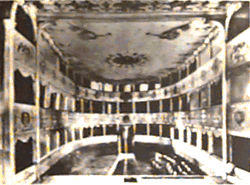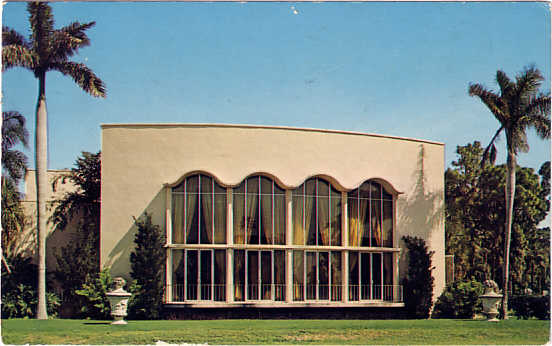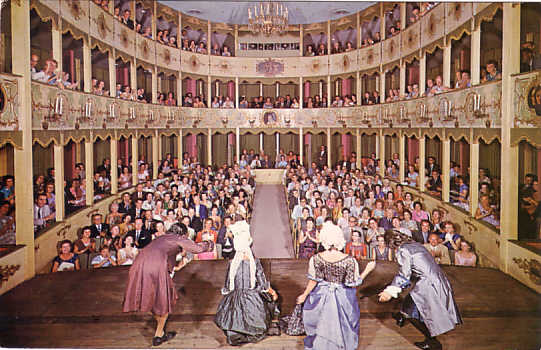The Original Asolo Theater
by Lin Vertefeuille (Ringling Museum Docent), October
2000
Photos and comments added (with*.*) by Willem van Osnabrugge in November 2005
The original Asolo Theater's evolution began in the fifteenth century when Venice had
trouble holding onto its overseas empire. Its weak ally, the King of Cyprus, was plagued
by revolts and decided that political ties could be strengthened by a marriage alliance
with Venice. Since Venice was a republic without a royal family, a leading merchant's
daughter, Caterina Cornaro, was selected as "Daughter of the Republic," to
become the King's bride. After the King's death a year later, Venice eventually annexed
Cyprus. In compensation Queen Caterina was given a royal court in the small town of Asolo,
forty miles northwest of Venice. She built her palace in a medieval fort and lived there
twenty years. Queen Caterina was not just a pretty face - her court attracted great
Italian poets and writers. After her death in 1509, the castle became a municipal building
occupied by the Venetian governor. After Napoleon's invasion of Italy, when Austrian and
French troops passed back and forth, the building was vacant.
In 1797 the Town gave permission for Antonio Locatelli to privatize and build a theater
"of boards" inside the great hall of the palace, possibly to provide
entertainment for a troop garrison. It was inaugurated, November 20, 1798, by the company
of Antonio Rosa. Its design was horseshoe shaped with box seats in back and seats rising
straight up three levels. It was Rococo in style. Seven portrait medallions were
decorations with the central portrait of Caterina presiding directly above the "royal
box." The other six medallions celebrated famous dramatists and poets of Italy who
were identified by initials of their names. They were: Dante (D.A.) and Petrarch (F.P.)
the great fourteenth century poets ; Ariosto (L.A.) and Tasso (T.T.) the epic poets ;
Carlo Goldoni (C.G.) comedy and Pietro Metastasio (P.M.) tragedy playwright of the
sixteenth century. On each side of the proscenium is a medallion with three masks
representing comedy, tragedy and satire or pastoral plays, the third leading form in the
Italian tradition. Flying figures above the royal box are hard to interpret but were most
likely symbolic spirits of the theater: Delight, Merriment and Love. Many prominent actors
and actresses performed in the theater until 1885. Eleanora Duse began her career there,
toured the United States and was eventually buried in Asolo.
In 1855 the little theater needed repair and was purchased from private owners by the
Society of Box Holders. Municipal architect, Francesco Martinago, was hired to refurbish
and reconstruct it. He was careful to retain its original design and at this time two more
medallions were added. Next to Caterina's portrait was added the medallion of Antonio
Canova (A.C.) 1757-1821, the greatest eighteenth century sculptor who was born only five
miles from Asolo. The other medallion placed next to the proscenium was Vittorio Alfredi
(V.A.) 1747-1803, a tragedy playwright.
 |
|
In the 1800s the Town of Asolo was popular with English artists and writers,
especially the romantics - Browning, Bryon, George Sand and Shelley. Robert Browning's
last work was Asolando. He enjoyed performances in the theater. At the end of the
nineteenth century, it was little used and finally during the Fascist period in 1930, it
was decided to dismantle and convert the hall into a motion picture theater. Adolph Loewi,
the German Consul in Venice and antique dealer, liked its Rococo details, purchased and
stored it for twenty years. |
His friend, A. Everett Austin, then Director of the Hartford Athenaeum was
a theater professional and expert in eighteenth century decorative arts. He was excited
when shown the disassembled theater, but was unable to purchase it because he had already
installed the Avery Theater in the Athenaeum.
During the War the theater continued to reside in a warehouse in Venice.
When Everett Austin became Ringling Museum's first director, in 1946, he began making
arrangements to purchase the theater. It was purchased for $8000 and shipped to Tampa ,
then installed in Gallery 21 in 1950. The components brought from Italy included the
proscenium arch, the curving walls with medallions, ceiling ornaments, valances over each
box and some smaller elements. Only the ground floor was installed in Gallery 21 because
there wasn't room for the staircase. The opening performance, February 26, 1952, was the
eighteenth century opera, La Serva Padrona by Pergolesi and Bastien et
Bastienne, by Mozart. Everett Austin designed the costumes for Bastien.
During the next few years the Asolo was in constant use for a variety of functions:
chamber music, plays, movies and lectures. A museum symposium a artists and art historians
from several museums and universities was held there annually 1949-1959 and closed with
productions by FSU students.
In 1957 the theater got its own building and moved from Gallery 21 to a new building.
*West of the Art Galleries' north wing (building removed in 2004)*. The new building,
keeping the same auditorium proportions as Caterina's palace hall, was completed with an
additional large lobby. The grand opening, January 10, 1958, was celebrated with the
performance of Mozart's Abduction from Seraglio. Life Magazine featured the
opening in its February 17, 1958 issue, giving it national prominence. The eighteenth
century atmosphere was enhanced in the lobby by period furniture donated by Everett Austin
including settees, chairs and a carved gilded table. On the walls of the second and third
levels, numerous items from the Museum's Theater Collection were hung reflecting the
Baroque Age. This included engravings by Jacque Callot representing characters from
Comedia dell' Arte and fifteen of the Disguises of Harlequin, by Giovanni Domenico
Ferretti (1692-1768), now in Gallery 16.
In the 1960s a repertory of five performances each of seventeenth and eighteenth century
comedies involved FSU graduates and students from the Yale School of Drama. The schedule
expanded to include Baroque operas. Eventually, latter in the 1960s operatic productions
were eliminated and were replaced by dramas and comedies including Shakespear . National
fame came to the Asolo in 1975 when PBS Theater in America chose it as one of
eight companies to be featured in a television series. They performed The Patriot
for the series and in 1977 The End of Summer which starred Helen Hayes.

* The Ringling Asolo Building from 1958 till 2004.*

* Interior Ringling Asolo Theater. Postcard from 1970s.*
In the late 1980s supporters identified the need and planned a new
state-of-the-art theater with over 500 seats, an open stage, built-in video taping
facilities, rehearsal area, shop and office space. It was to be the home of FSU graduate
programs in television, acting and broadcast arts. The new Asolo theater, on Tamiami was
born! *The inside Victorian theater was bought in Schotland.* The last production (1989)
in the original Asolo was Cyrano de Bergerac because it had been the most popular
play in its Florida history. At the end of the performance, the audience, company and
staff walked in a candlelit procession from the original Asolo to the new theater. The
original Asolo Theater has a fifty year history at the Museum and a wonderful 200 year
past.
ringlingdocents.org
|


